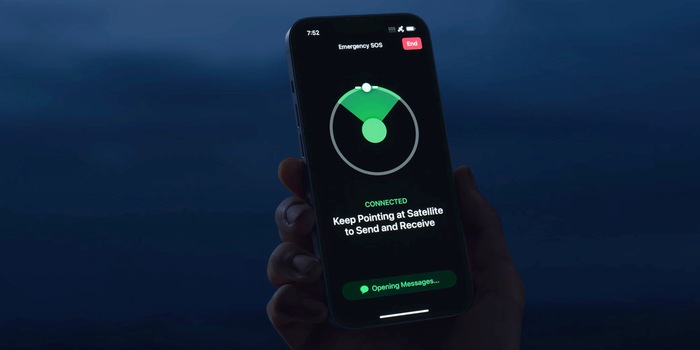
Apple's satellite emergency call now works in Switzerland
Apple's emergency call service via satellite is now also available in Switzerland. You will need an iPhone 14 or iPhone 15 with iOS 17.
From today, you can also use Apple's Satellite Emergency Call in Switzerland and Spain. The company announced this on Friday morning in a press release. The feature enables emergency services to be alerted in areas without mobile phone reception. It works with all iPhone 14 and iPhone 15 models and is integrated directly into the iOS operating system. The service is free for two years, but it is not yet clear how much it will cost afterwards.
How it works
If you dial the emergency call and have no reception, the iPhone automatically switches to satellite mode. It only works outdoors and you need as clear a view of the sky as possible. Clouds are not a problem, but large buildings can be an obstacle. Important to know: To use the service in Switzerland, you need iOS 17.
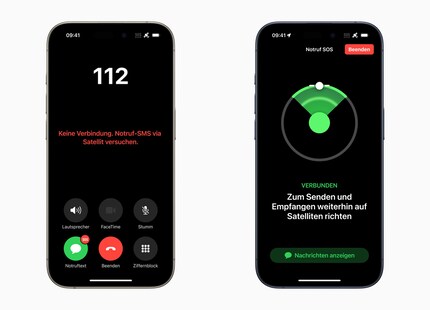
Source: Apple
As the bandwidth via satellite is not sufficient for a voice call, a text message is transmitted instead. In a short questionnaire, you can provide important information about your emergency situation with just a few clicks. For example, what kind of emergency it is, who needs help or whether you can still breathe normally. The iPhone compresses this information into a special small format.
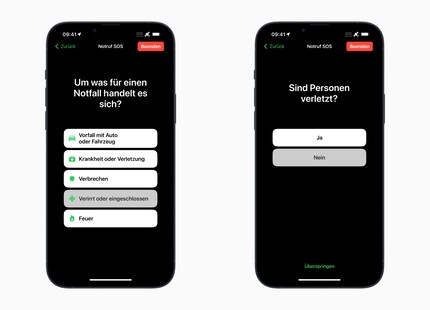
Source: Apple
An interface then shows you how to orientate your smartphone in order to establish a satellite connection as quickly as possible. If you are unable to move, it will also work, but may take longer. As soon as a connection is established, the iPhone sends the text message to a special relay centre - which also contains your location, your emergency passport and your emergency contacts.
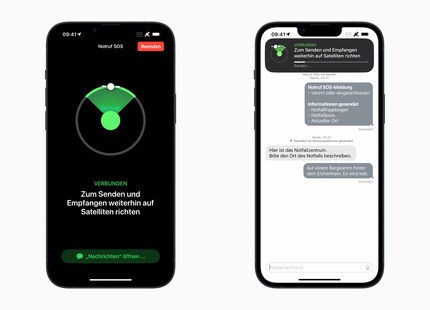
Source: Apple
Unlike a specialised satellite phone, an iPhone does not have a large antenna. Because satellites move quickly and are far away, it can take several minutes for the message to be transmitted. In clear weather conditions, the best case scenario is around 15 seconds. As soon as the relay centre has received the emergency call, you will also receive a confirmation by text message. The employees can also ask questions about your situation. If you have defined emergency contacts, they can read the conversation.
The Relay Centre uses the information collected to contact the local emergency services. In Switzerland, for example, this would be the police, the rescue service or Rega. They then move out and come to your aid.
Where it works everywhere
Apple's Satellite Emergency Call is currently available in the following countries: USA, Canada, Australia, New Zealand, UK, Ireland, Switzerland, Germany, Austria, Luxembourg, Netherlands, France, Italy, Portugal and Spain. Apple wants to expand the service further. The Californians are working with Globalstar for the satellite connection. Their network covers large parts of all five continents.
Where you bought your iPhone doesn't matter. Even a device from the Czech Republic can call for help via satellite in Switzerland, for example. Exceptions are iPhones from China, Hong Kong and Macau - the feature does not work with these devices.
How you can prepare yourself
So that you are already familiar with the satellite emergency call if the worst comes to the worst, you can try out the function in a demo mode. The iPhone will guide you through the whole process and provide various explanations. You have to point your device at a satellite as if you were in a real emergency and can talk to a bot.
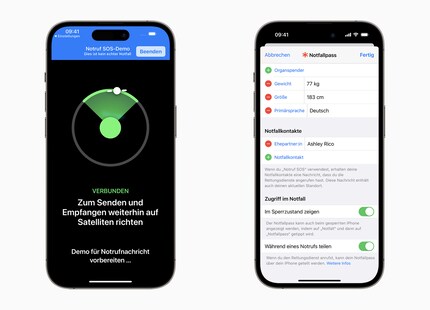
Source: Apple
What you should also do before an emergency: Fill out your emergency passport and define your emergency contacts. You can do this in the "Health" app. You will find the option on the overview page if you scroll down a little. You can find detailed instructions here. The emergency passport includes information such as your blood group, allergies and whether you would like to donate your organs in the event of death.
Even without an emergency: "Where is?" via satellite
In the "Find My" app, you can use your iPhone's satellite connection to share your location with friends and family without a mobile data connection, even without an emergency. This is useful, for example, if you want to signal that everything is OK in an area without reception.
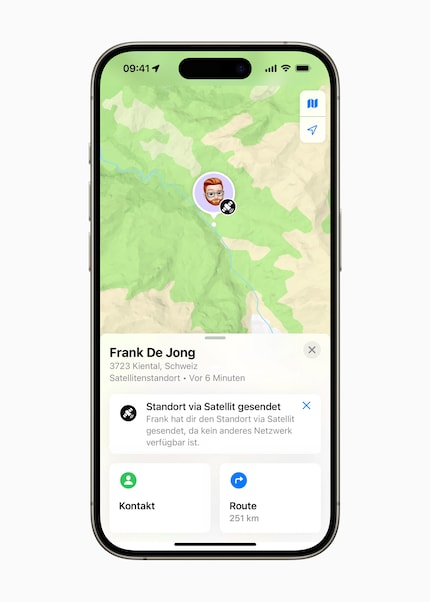
Source: Apple
You can find the option in the app under the "Me" tab. The location sharing via satellite is not continuous, but unique. This means that the recipients of your location cannot track it live, as would be possible with a data connection.
Open questions
Apple has not yet provided any information on some points - such as the price. The satellite function is free for two years after purchasing an iPhone 14 or iPhone 15. If you already have an iPhone 14, this period only starts now. Apple either doesn't yet know exactly what will happen after that, or is keeping quiet about it. It's hard to imagine that the iPhone will refuse to make an emergency call in an emergency if you haven't paid a subscription fee. It is therefore conceivable that in such a case, a one-off fee will be charged instead.
According to Apple, the messages are sent in encrypted form and are only decrypted at the Relay Centre. Where these centres are located and who exactly operates them is not known. Apple speaks of "trained emergency specialists". The diversions via a relay centre is necessary because certain emergency services only accept voice calls.
Cover image: Screenshot YouTube / Apple
My fingerprint often changes so drastically that my MacBook doesn't recognise it anymore. The reason? If I'm not clinging to a monitor or camera, I'm probably clinging to a rockface by the tips of my fingers.
From the latest iPhone to the return of 80s fashion. The editorial team will help you make sense of it all.
Show all